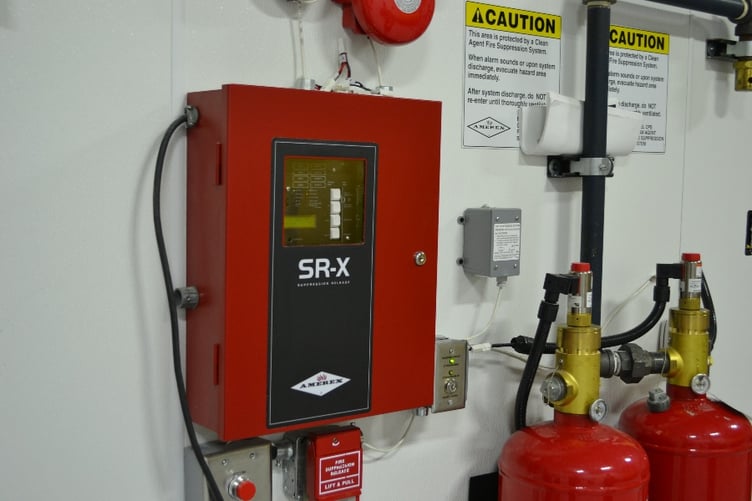What is a Clean Agent Fire Suppression System?
A clean agent fire suppression system is used in sensitive environments where a fire sprinkler system could create tremendous damage from the water it uses to suppress or extinguish a fire. Some of these sensitive environments where you might find a clean agent fire suppression system include server rooms, museums, art galleries, data centers, and telecommunication centers.
When a fire is detected, a clean agent fire suppression system will release or dump its clean agent into the sensitive environment. The system is designed to flood the protected area with the clean agent. The clean agent suppresses or extinguishes the fire by either reducing the heat or reducing the presence of oxygen or both, depending on the type of clean agent used.
What are the Main Parts of a Clean Agent Fire Suppression System?
A clean agent fire suppression system begins with the detection devices and ends with the nozzles where the clean agent is released. From the detection of the fire to the releasing of the agent, there are numerous devices to make the whole system run efficiently. Below are some of the most common parts of a clean agent fire suppression system:
- Smoke Detectors: If a fire begins in the protected area, the smoke detector will detect the fire and send a signal to the control panel. Smoke detectors will usually sense the fire before it has had time to escalate.
- Control Panel: The control panel is the brains of the system. When it receives a signal from the detectors, it then sends a signal to sound the notification devices and activate the release device to suppress the fire.
- Notification Devices: To warn those around or in the protected area that the fire suppression system is preparing to activate and release the clean agent, the control panel activates the alarm horns and strobes. The horns create a loud audible alert while the strobes create a bright visual alert.
- Release Device: The release device is attached to the cylinder and is activated by the control panel. The control panel activates the release device after a fire is detected, allowing the clean agent to escape from the cylinder and flood the protected area.
- Cylinder/s: The cylinder is where the clean agent is stored. Depending on the size of the protected space, there can be multiple cylinders or one very large cylinder. Some clean agents are stored as a gas while others are stored as a liquid gas.
- Nozzles: Once the clean agent has been released from the cylinders, it travels down the pipes and exits out of the strategically placed nozzles. Nozzles in the middle of the protected space will be 360 degree nozzles allowing the clean agent to disperse all around the nozzle. Nozzles installed near walls will usually be 180 degree nozzles which disperses the clean agent away from the wall.
- Abort Switch: The abort switch is usually a large button that is located near the clean agent system or near the door of the protected space. By depressing the button and holding it, the system is paused allowing personnel to evacuate of the area before the clean agent is dispersed. Once everyone has evacuated, the button can be released and the system will continue the process of activating the clean agent system. Note that this button will not stop the system from activating. It will only delay the system from activating.
- Maintenance Switch: All fire suppression systems require routine inspections and maintenance. The maintenance switch can be used during the inspections to turn off the system so it doesn’t accidentally discharge during maintenance.
- Manual Release: The manual release allows personnel to bypass the normal process described above and activate the system and release the clean agent manually. Once the release has been pulled, the clean agent fire suppression system will activate, sending the agent through the system and out the nozzles to suppress the fire.
Have More Questions About Clean Agent Fire Suppression Systems?
To learn more about clean agent fire suppression systems, contact a Koorsen Fire & Security suppression expert today. Koorsen's fire suppression experts can help answer any questions you may have about all types of fire suppression systems. Koorsen has decades of experience in designing, installing, inspecting, and maintaining fire suppression systems for businesses in all industries.



